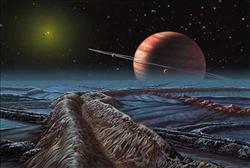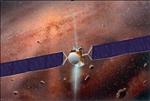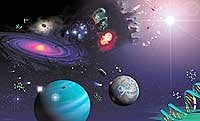Lynette Cook has an extensive background in scientific illustration, ranging from astronomy to zoology. After completing her master’s degree in fine arts in 1984, Cook worked as an artist and photographer for the Morrision Planetarium in San Francisco for many years.
Over the years, her freelance work drew her into astronomical illustration, creating a unique niche as a space artist. Cook’s paintings usually involve mixed media, including watercolor, colored pencil, and acrylic.
Cook’s best known works are of extrasolar planets, which she began painting after the first confirmed discovery in 1995. To add realism, she consults with the planets’ discoverers. Her scenes of extrasolar worlds appear in leading periodicals, television documentaries, and newspapers in North America and overseas.
Helping educate the public on this groundbreaking discipline, Cook regards herself fortunate to be able to create visions of worlds that cannot be imaged directly.
Find out more about Lynette Cook and view more of her artwork.
The art director of the Griffith Observatory in Los Angeles, Don Dixon uses both traditional media and digital methods to create art.
A freelance illustrator and animator since 1972, Dixon’s artwork has graced dozens of book and magazine covers. The artistry of Stanley Kubrick’s special effects in 2001: A Space Odyssey strongly influenced Dixon. His own pre-production work includes design and special effects storyboards for movies and television.
Most notably, he worked on the background art for Carl Sagan’s Cosmos television series and animated several NASA films. He designed the official JPL logo for the Pioneer encounter with Saturn and was the primary illustrator for the Hubble Space Telescope’s traveling exhibit for the Smithsonian Institution.
Galactic black holes and the formation of ancient Earth are among Dixon’s favorite space phenomena to paint, and he says he’d have loved to witness the formation of our Moon (from a safe distance).
Find out more about Dixon’s work and more about his background .
A senior scientist at the Planetary Research Institute in Tucson, Arizona, and a NASA planetary mission specialist, William Hartmann brings keen insight to planetary vistas rendered in his paintings.
His own research in the early 1970s included the study of cratering on the Moon, which led to a widely accepted model of the origin of our nearest neighbor. Currently, Hartmann is involved with the Mars Global Surveyor mission and studies geological activities on the Red Planet.
More an artist than a technical illustrator, Hartmann’s love for art began as a child, inspired by his grandfather who was an artist himself. Hartmann grew up with the wondrous visions of Chesley Bonestell, which piqued his interest in astronomy.
While teaching college, Hartmann seriously began painting and illustrated his own astronomical textbooks. This led to his artwork being published in numerous articles, magazines, and books. Much of his work is based on recent science discoveries in the solar system. Hartmann likes his pieces to “have a certain interest at the abstract compositional and sometimes textural levels.”
Hartmann is the author of Mars Underground, a science-fiction novel, and most recently, a non-fiction overview of research on the Red Planet titled A Traveler’s Guide to Mars. He also completed a colossal mural for the Chabot Space and Science Center in Oakland, California.
Find out more about Hartmann’s work and more about his background.
The credit line for most NASA renditions of planetary missions often reads “courtesy NASA.” Many, however, are the handiwork of Pat Rawlings, who uses everything from topographical maps to models to achieve a high level of credibility in his paintings.
Most of Rawlings’s work includes some form of technology, and he is considered a leader in the “hardware” space-art niche. His illustrations of extraterrestrial landscapes often include landers and space ships and focus on future milestone events in space exploration. He enjoys experimenting with different points of view in his paintings and considers himself a “visual storyteller.”
One of his most recognized landscapes is a NASA commissioned piece, “First light,” depicting astronauts exploring martian canyons.Indeed, Rawlings considers the Red Planet his second home and would love a ringside seat at the rim of Valles Marineris.
Find out more about Rawlings’ work and more about his background .












